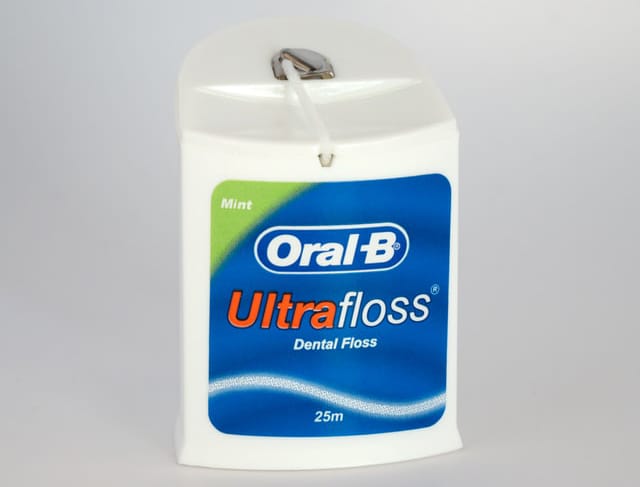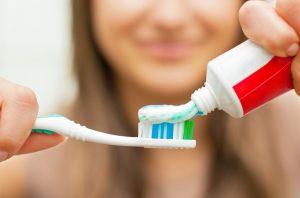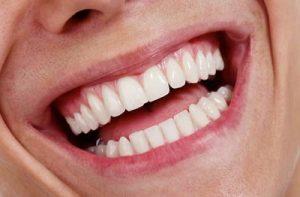There’s no way to sugarcoat this: brushing is good, but it’s not quite enough.

If you’re brushing your teeth with fluoride toothpaste twice a day and sticking to a relatively sugar-free diet, then – seriously – good for you. You’re well on your way to a good home oral hygiene routine.
But it’s not quite enough.
You must add flossing (or better still, interdental brushing) to your daily regimen if you want to keep your teeth clean, breath fresh and keep gum disease at bay.
 Brushing twice daily with fluoride toothpaste is an excellent way to help remove debris and plaque – and the fluoride in toothpaste will help fortify your enamel. Toothpaste is fantastic stuff – so don’t be in a rush to remove it. After brushing, spit out the toothpaste but don’t rinse it away with water. According to the Australian Dental Association, a little bit of toothpaste residue will give your teeth a handy boost of ongoing protection.
Brushing twice daily with fluoride toothpaste is an excellent way to help remove debris and plaque – and the fluoride in toothpaste will help fortify your enamel. Toothpaste is fantastic stuff – so don’t be in a rush to remove it. After brushing, spit out the toothpaste but don’t rinse it away with water. According to the Australian Dental Association, a little bit of toothpaste residue will give your teeth a handy boost of ongoing protection.
Although brushing is good, it can’t reach all the areas of your teeth. According to the Australian Dental Association, a whopping 50% of the surface area of your teeth remain untouched by your toothbrush. This is why flossing or interdental brushing is so important. And if you floss or interdental brush once a day, you’ll help to do the following.
Keep your teeth healthy
If food debris is stuck between your teeth, the bacteria and plaque will weaken and erode your tooth enamel, eventually leading to cavities. And if that’s not enough to incentivise you, think of vanity. Flossing or interdental brushing is the only way to eliminate unsightly food particles left in your teeth.
Keep your breath fresh
Again, brushing is excellent, but if you’re wondering why your breath is a little less than fresh, it could be due to food particles trapped in your teeth. And the bacteria that feed off these particles will not smell nice. They could even smell quite putrid. So why not give them a quick floss/interdental brush and get back that fresh breath confidence!
Prevent gum disease
If you don’t floss or clean between the teeth properly, the debris left behind in your teeth can irritate the gums and cause gum disease. According to the Australian Government Department of Health, gum disease (periodontal disease) is highly prevalent in Australia, with 22.9% of Australians suffering moderate or severe periodontitis. Stage one of gum disease is gingivitis, a common and reversible condition where your gums become red and swollen and easily bleed when brushing. If you leave gingivitis untreated, then it becomes periodontitis. Periodontitis is stage II of periodontal disease and is not reversible. The best you can hope to do is manage it. You can read more about gum disease at Better Health Channel.
Care for your overall health
 A healthy mouth, teeth and gums mean less time in the dentist chair – and less unnecessary expense. But it also means less chance of causing health problems throughout your body. Suppose your mouth is harbouring harmful bacteria from, for example, gum disease. In that case, this bacteria can occasionally travel to other parts of the body, increasing your risk to diabetes, heart disease and respiratory illness. So avoid putting unnecessary stress on your body and vital organs, do yourself a favour and take a couple of moments to clean in between your teeth each day properly.
A healthy mouth, teeth and gums mean less time in the dentist chair – and less unnecessary expense. But it also means less chance of causing health problems throughout your body. Suppose your mouth is harbouring harmful bacteria from, for example, gum disease. In that case, this bacteria can occasionally travel to other parts of the body, increasing your risk to diabetes, heart disease and respiratory illness. So avoid putting unnecessary stress on your body and vital organs, do yourself a favour and take a couple of moments to clean in between your teeth each day properly.
How to floss
Flossing is relatively simple. Here are some simple guidelines, as outlined by the ADA. If you’re confused, though, speak to one of our dentists or oral hygienists. They’ll be glad you did.
- Cut a good 45 cm of dental floss (anything less makes the task too tricky)
- Wind the ends of the floss around the middle fingers, then gripped tightly between your index fingers and thumbs.
- Gently place the floss between two teeth, then glide the floss up and down, rubbing it against both sides of each to
- When cleaning the neck of the tooth (the bottom bit near the gums) curl the floss around the neck in a C shape, then gently let it slide down under the gum. Do not snap the floss or push the gums.
- As you move from tooth to tooth, ensure that you use a fresh piece of your floss
About interdental brushing
Interdental brushing is increasing in popularity with multiple studies proving it to be more effective than flossing. Not only do their bristles make interdental cleaning more effective, but they are softer on gums, more successful at reducing periodontal pocket size and produce less bleeding (a pertinent issue for those with gum disease). And for many, they are easier to use than dental floss. However, either method – when combined with twice-daily brushing– vastly improves oral hygiene compared to no interdental cleaning at all. Speak to your dentist to see which method is more suitable for you.
References:
- Dental Health Week 2021: the Australian Dental Association (Flossing): https://www.ada.org.au/Dental-Health-Week-2017/Oral-Health-for-Busy-Lives/Flossing
- Dental Health Week 2021: the Australian Dental Association (Brushing):
- https://www.ada.org.au/Dental-Health-Week-2017/Oral-Health-for-Busy-Lives/Brushing
- Oral Health and Visiting Patterns of Australian Adults – the Department of Health: https://www1.health.gov.au/internet/publications/publishing.nsf/Content/report_nacdh~report_nacdh_ch1~report_nacdh_ad#:~:text=Periodontitis,of%20periodontitis%20than%20younger%20people.
- Gum Disease: Better Health Channel: https://www.betterhealth.vic.gov.au/health/conditionsandtreatments/gum-disease
- An Overview of Different Interdental Cleaning Aids and Their Effectiveness https://www.ncbi.nlm.nih.gov/pmc/articles/PMC6630384/
Contact Us
Talk to us about your dental health – or organise an appointment today.
